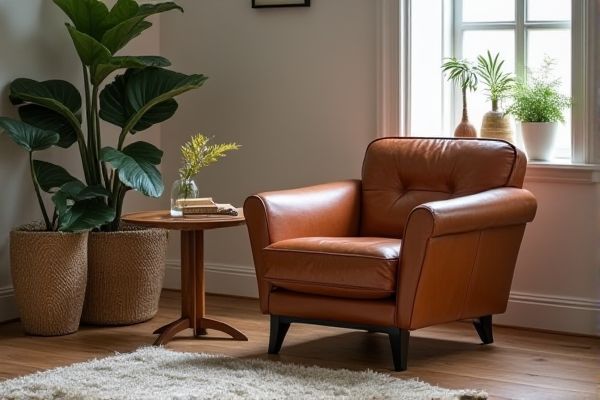
Leather chairs offer durability, a luxurious feel, and develop a unique patina over time, while faux leather chairs provide affordability, ease of maintenance, and a cruelty-free alternative without sacrificing style. Discover which option best suits your needs and preferences by reading the rest of the article.
Table of Comparison
| Feature | Leather Chair | Faux Leather Chair |
|---|---|---|
| Material | Genuine animal hide | Synthetic materials (PU, PVC) |
| Durability | High, lasts many years with care | Moderate, prone to cracking over time |
| Maintenance | Requires conditioning and cleaning | Easy to clean with mild soap |
| Comfort | Breathable, softens with use | Less breathable, may feel stiffer |
| Cost | Expensive | Affordable |
| Environmental Impact | Animal-based, higher ecological footprint | Petroleum-based, but cruelty-free |
| Appearance | Natural texture, ages gracefully | Uniform finish, less natural look |
| Allergy Consideration | Possible allergen for some | Hypoallergenic option |
Introduction: Leather vs Faux Leather Chairs
Leather chairs offer unparalleled durability and natural breathability, making them ideal for long-term use and comfort. Faux leather chairs are more affordable and resistant to stains, providing an easy-to-clean alternative with a similar aesthetic appeal. Your choice depends on budget, maintenance preferences, and desired longevity.
Material Composition and Characteristics
Leather chairs are crafted from natural animal hides, offering unique texture, breathability, and durability that improves with age. Faux leather chairs consist of synthetic materials such as polyurethane or polyvinyl chloride (PVC), providing a uniform appearance, greater resistance to stains, and lower cost compared to genuine leather. While genuine leather offers better longevity and natural aging patterns, faux leather excels in ease of maintenance and ethical considerations.
Appearance and Design Options
Leather chairs offer a luxurious, natural texture with unique grain patterns that develop a rich patina over time, enhancing their aesthetic appeal. Faux leather chairs provide a versatile range of colors and finishes, allowing for sleek, modern designs that mimic genuine leather while being more budget-friendly. Your choice depends on whether you prioritize authentic craftsmanship or a wider array of stylish, customizable options.
Comfort and Feel
Leather chairs provide a natural softness and breathability, conforming comfortably to your body over time for an enhanced seating experience. Faux leather chairs often offer a firmer texture and less breathability, which might lead to increased warmth and less cushioning comfort during extended use. Your choice between leather and faux leather should consider how much softness and temperature regulation matter to your comfort preferences.
Durability and Longevity
Leather chairs offer superior durability and longevity due to natural resistance to wear and tear, making them a long-term investment for your seating needs. Faux leather chairs, while more affordable, tend to wear out faster, showing cracks and peeling with prolonged use. Choosing genuine leather ensures sustained comfort and appearance, especially in high-traffic environments.
Maintenance and Cleaning
Leather chairs require regular conditioning and gentle cleaning with leather-specific products to maintain their suppleness and prevent cracking. Faux leather chairs offer easier maintenance, as they can be wiped clean with mild soap and water without the need for special conditioners. Over time, genuine leather develops a patina that adds character, whereas faux leather may be prone to peeling or cracking despite simpler upkeep.
Environmental Impact
Leather chairs have a higher environmental impact due to intensive livestock farming, which contributes to deforestation, methane emissions, and water consumption. Faux leather chairs use synthetic materials derived from plastics, leading to pollution and non-biodegradable waste but often require fewer natural resources to produce. Your choice between leather and faux leather affects sustainability, with faux leather offering a more eco-friendly option if produced with recycled materials.
Cost and Affordability
Leather chairs typically cost significantly more due to the quality and durability of genuine leather, often ranging from $300 to over $1,000. Faux leather chairs offer a more affordable alternative, usually priced between $100 and $400, making them budget-friendly for consumers seeking the look of leather without the high investment. While faux leather may require more frequent replacement, its lower upfront cost appeals to cost-conscious buyers prioritizing affordability.
Common Use Cases and Suitability
Leather chairs are ideal for executive offices and luxury settings due to their durability, natural breathability, and ability to develop a rich patina over time. Faux leather chairs offer a budget-friendly alternative commonly used in home offices, casual meeting rooms, and waiting areas, providing easy maintenance and resistance to stains. Both materials suit different environments based on aesthetic preference, frequency of use, and care requirements.
Final Comparison: Which Chair is Best for You?
Leather chairs offer unmatched durability, natural breathability, and develop a unique patina over time, making them ideal for long-term investment and luxury comfort. Faux leather chairs provide a cost-effective, animal-friendly alternative with easier maintenance and resistance to stains, suitable for budget-conscious users or those prioritizing ethical choices. Choosing between leather and faux leather chairs depends on your preferences for longevity, aesthetics, environmental impact, and budget constraints.
 homyna.com
homyna.com